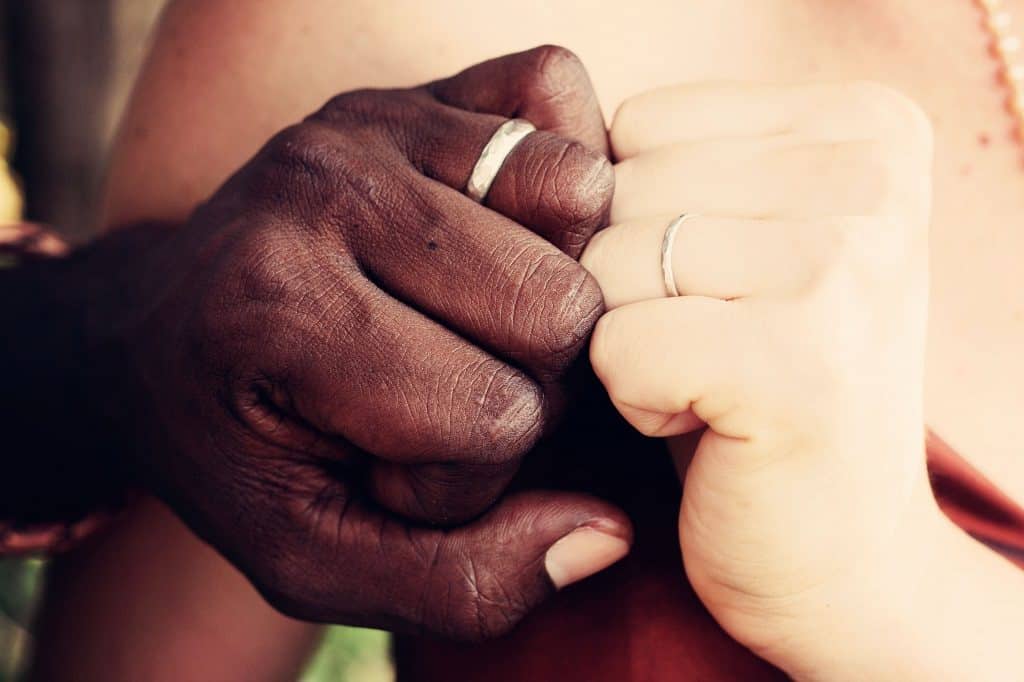Your wedding rings or bands have a vital role to play not just during your wedding ceremony but for the rest of your married life. Whatever style you go for, the wedding ring signifies eternal togetherness, and has done since they were introduced more than 5,000 years ago in ancient Egypt. With love, devotion, commitment, honour, fidelity, and respect all signified in this little piece of jewellery, picking the ring that you’ll wear for the rest of your life shouldn’t be taken lightly.

There are many dos and don’ts for picking the perfect wedding band for you, but the question on every couple’s lips as they make their selection is – do our rings have to match?
What tradition says
Traditionally wedding bands don’t have to match but they do have to be similar. It’s important to acknowledge that both partners have their own unique personalities, which makes some styles and metals more suitable than others.
Women tend to opt for jewelled or more intricate designs. They also tend to choose precious metals, such as white gold, yellow gold, rose gold, and platinum, while men tend to opt for alternative metals like titanium, tungsten, and cobalt.
Generally, couples tend to choose a similar style and colour, even if they do have different metal preferences. Metals are now available in a vast range of shades, so even if you each opt for different metals you can still match in colour.
What modern couples are doing
Most modern couples are waving “goodbye” to tradition when selecting their wedding bands. Most aren’t concerned about matching, with partners choosing their preferred wedding ring in accordance to their own style and metal preferences, and we don’t blame them. Wedding planning is stressful enough without adding ‘find matching wedding rings’ to your list of dilemmas.
More importantly, your wedding band should be of a style and colour that you not just like but love. It’s the one piece of jewellery that you’ll wear day in, day out, so has to complement your personality perfectly.
Having your unique rings engraved with the same sentimental messages or romantic quotes is a great way to celebrate your togetherness, even if your wedding band styles are poles apart.
Want the best of both worlds?
The latest wedding trend makes deciding between matching wedding bands and different styles easy. The two ring movement means you don’t have to choose at all.
Many modern brides and grooms are buying two wedding bands, one which will be worn daily that suits their individual style and metal preference, and another that matches their partner’s wedding band. The matching wedding band is generally worn for weddings and other special occasions. The latter tends to be more ornate and dressy, whilst the first band is hardy and individual making it perfect for everyday use.
As Bella’s Fine Jewelry and Style Blog explains some people wear both wedding bands with their engagement ring, here’s just one of the reasons why:
“Many brides like the symmetry of wearing two wedding bands. They feel when you only wear one wedding band that it makes your wedding set look lopsided and unbalanced. They feel that by wearing two wedding bands you are keeping your engagement set symmetric. However, some brides feel the two band look takes away from the tradition and meaning of a single wedding band. Regardless, there are pros and cons to every look. You just need to decide what is right for you.”
Whether you want to stick with tradition, complement your individuality or have the best of both worlds, finding the perfect wedding band for you takes time. Say “I do” to your dream ring by starting your ring search early and shopping around.
